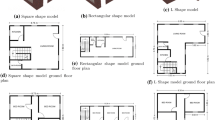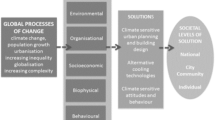Abstract
The Universal Thermal Climate Index (UTCI) was conceived as a thermal index covering the whole climate range from heat to cold. This would be impossible without considering clothing as the interface between the person (here, the physiological model of thermoregulation) and the environment. It was decided to develop a clothing model for this application in which the following three factors were considered: (1) typical dressing behaviour in different temperatures, as observed in the field, resulting in a model of the distribution of clothing over the different body segments in relation to the ambient temperature, (2) the changes in clothing insulation and vapour resistance caused by wind and body movement, and (3) the change in wind speed in relation to the height above ground. The outcome was a clothing model that defines in detail the effective clothing insulation and vapour resistance for each of the thermo-physiological model’s body segments over a wide range of climatic conditions. This paper details this model’s conception and documents its definitions.







Similar content being viewed by others
References
Al-ajmi FF, Loveday DL, Bedwell KH, Havenith G (2008) Thermal insulation and clothing area factors of typical Arabian Gulf clothing ensembles for males and females: measurements using thermal manikins. Appl Ergon 39:407–414
Blazejczyk K (2004) Bioklimatyczneuwarunkowaniarekreacji i turystyki w Polsce [Bioclimatic principles of recreation and tourism in Poland]. PraceGeograficzneIGiPZ PAN 192:291
Blazejczyk K, Twardosz R (2002) Changes in human heat balance during prolonged outdoors exposition at various weather conditions. Environmental Ergonomics X, Papers from the 10th International Conference on Environmental Ergonomics, Fukuoka, Japan, 23–27 September 2002: pp 71–74
Błażejczyk K, Twardosz R (2006) Strukturabilansucieplnegoczlowieka w róznychwarunkachpogodowych i przyróznejaktywnoscifizycznej. [Structure of human heat balance in various Feather conditions and at various activity] In: Trepińska J, Olecki Z (eds) Klimatyczneaspektysrodowiskageograficznego. Inst Geogr iGosp Przestrz UJ, Kraków, pp 161–172
Bröde P, Krüger EL, Rossi FA, Fiala D (2011) Predicting urban outdoor thermal comfort by the Universal Thermal Climate Index UTCI – a Case Study from Southern Brazil. Int J Biometeorol, this special issue. doi:10.1007/s00484-011-0452-3
Donaldson GC, Tchernjavskii VE, Ermakov SP, Bucher K, Keatinge WR (1998) Winter mortality and cold stress in Yekaterinburg, Russia: interview survey. BMJ 316:514–518
Donaldson GC, Rintamäki H, Näyhä S (2001) Outdoor clothing: its relationship to geography, climate, behavior and cold-related mortality in Europe. Int J Biometeorol 45:45–51
Fiala D, Lomas KJ, Stohrer M (1999) A computer model of human thermoregulation for a wide range of environmental conditions: the passive system. J Appl Physiol 87:1957–1972
Fiala D, Lomas KJ, Stohrer M (2001) Computer prediction of human thermoregulatory andtemperature responses to a wide range of environmental conditions. Int J Biometeorology 45(2):143–159
Fiala D, Psikuta A, Jendritzky G, Paulke S, Nelson DA, van Marken Lichtenbelt WD, Frijns AJH (2010) Physiological modeling for technical, clinical and research applications. Front Biosci S2:939–968
Fiala D, Havenith G, Bröde P, Kampmann B, Jendritzky G (2011) UTCI-Fiala multi-node model of human temperature regulation and thermal comfort. Int J Biometeorol, this issue. doi:10.1007/s00484-011-0424-7
Gavhed D, Holmér I (1989) Protection against cold by a standard winter clothing during moderate activity. In: Third Scandinavian Symposium on Protective Clothing against chemicals and other Health Risks. Defense Research Establishment, Gausdal, pp 4
Goodwin J, Taylor RS, Pearce VR, Read KLQ (2000) Seasonal cold, excursionalbehavior, clothing protection and physical activity and old subjects. Intl J Circumpolar Health 59:195–203
Havenith G, Nilsson H (2004) Correction of clothing insulation for movement and wind effects, a meta-analysis. Eur J Appl Physiol 92:636–640
Havenith G, Nilsson H (2005) Correction of clothing insulation for movement and wind effects, a meta-analysis. Eur J Appl Physiol 93:506, Erratum to previous publication
Havenith G, Heus R, Lotens WA (1990a) Resultant clothing insulation: a function of body movement, posture, wind, clothing fit and ensemble thickness. Ergonomics 33/1:67–84
Havenith G, Heus R, Lotens WA (1990b) Clothing ventilation, vapour resistance and permeability index: changes due to posture, movement and wind. Ergonomics 33/8:989–1005
Havenith G, Holmér I, Den Hartog EA, Parsons KC (1999) Clothing evaporative heat resistance-proposal for improved representation in standards and models. Ann Occup Hyg 43(5):339–346, ISSN 0003 4878
Havenith G, Holmér I, Parsons KC (2002) Personal factors in thermal comfort assessment: clothing properties and metabolic heat production. Energy Build 34:581–591
Havenith G, Smith CJ, Fukazawa T (2008) The skin interface - meeting point of physiology and clothing science. Journal of Fiber Bioengineering and Informatics JFBI 1(No. 2):93–98
Holmér I, Nilsson H, Havenith G, Parsons KC (1999) Clothing convective heat exchange - proposal for improved prediction in standards and models. Ann Occup Hyg 43(5):329–337, ISSN 0003 4878
ISO (1989) BS EN 27243:1994, ISO 7243:1989 Hot environments. Estimation of the heat stress on working man, based on the WBGT-index (wet bulb globe temperature)
ISO (1999) BS EN ISO 9920:2009, Ergonomics of the thermal environment. Estimation of thermal insulation and water vapour resistance of a clothing ensemble
ISO (2007) BS EN ISO 11079:2007, Ergonomics of the thermal environment. Determination and interpretation of cold stress when using required clothing insulation (IREQ) and local cooling effects
Keatinge WR, Eurowinter Group (1997) Cold exposure and winter mortality from ischaemic heart disease, cerebrovascular disease, respiratory disease, and all causes, in warm and cold regions of Europe. Lancet 349:1341–1346
Lindner K (2010) Clothing as an indicator of human thermal comfort. In: Matzarakis A, Mayer H, Chmielewski F-M (Eds) Proceedings of the 7th Conference on Biometeorology, Freiburg, 12–14 April 2010 (pp 278–283). Freiburg: Univ., 2010 (Berichte des MeteorologischenInstituts der Albert-Ludwigs-Universität Freiburg, Nr. 20)
Mäkinen TM, Raatikka VP, Rytkönen M, Jokelainen J, Rintamäki H, Ruuhela R, Näyhä S, Hassi J (2006) Factors affecting outdoor exposure in winter: population-based study. Int J Biometeorol 51:27–36
McCullough EA, Jones BW, Huck J (1984) Acomprehensive data base for estimating clothing insulation. ASHRAE Trans 91(2):29–47
Nielsen R, Olesen BW, Fanger PO (1965) Effect of physical activityand air velocity on the thermal insulation of clothing. Ergonomics 28:1617–1632
Nilsson HO, Anttonen H, Holmér I (2000) New algorithms forprediction of wind effects on cold protective clothing. In: 1st European Conference on Protective Clothing. ArbeteochHaelsa8, Stockholm, pp 17–20
Olesen BW, Sliwinska E, Madsen TL, Fanger PO (1982) Effect of body posture and activity on the thermal insulation of clothing: measurements by a movable thermal manikin. ASHRAE Transact 88:791–805
Oliveira AVM, Gaspar AR, Quintela DA (2005) Thermal insulation of cold protective clothing: static and dynamic measurements with a movable thermal manikin, Environmental Ergonomics XI, Proceedings of the 11th International Conference, Ystad, Sweden, May 2005, pp 66–73, ISSN 1650-9773
Sprague C, Munson D (1974) A composite ensemble method for estimating thermal insulating values of clothing. ASHRAE Trans 80:120–125
Author information
Authors and Affiliations
Corresponding author
Rights and permissions
About this article
Cite this article
Havenith, G., Fiala, D., Błazejczyk, K. et al. The UTCI-clothing model. Int J Biometeorol 56, 461–470 (2012). https://doi.org/10.1007/s00484-011-0451-4
Received:
Revised:
Accepted:
Published:
Issue Date:
DOI: https://doi.org/10.1007/s00484-011-0451-4




